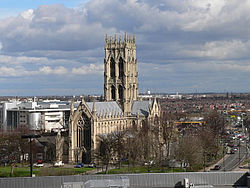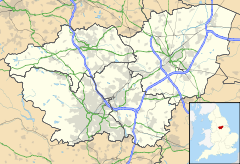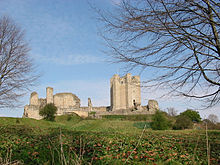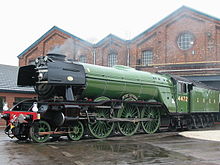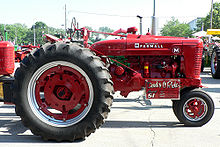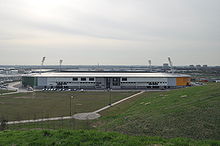- Doncaster
-
For other places with the same name, see Doncaster (disambiguation)
Coordinates: 53°30′58″N 1°07′59″W / 53.516°N 1.133°W
Doncaster
A view of Doncaster from the Frenchgate Centre
 Doncaster shown within South Yorkshire
Doncaster shown within South YorkshirePopulation 67,977 (2001 Census) OS grid reference SE5702 Metropolitan borough Doncaster Metropolitan county South Yorkshire Region Yorkshire and the Humber Country England Sovereign state United Kingdom Post town DONCASTER Postcode district DN1-DN12 Dialling code 01302 (or 01709 in some areas) Police South Yorkshire Fire South Yorkshire Ambulance Yorkshire EU Parliament Yorkshire and the Humber UK Parliament __Constituency Map Doncaster Central Doncaster North Don Valley Barnsley East Website Doncaster Council List of places: UK • England • Yorkshire Doncaster (
 /ˈdɒŋkɑːstə/,[1] Old English: Donne ceaster) is a town in South Yorkshire, England, and the principal settlement of the Metropolitan Borough of Doncaster. The town is about 20 miles (32 km) from Sheffield and is popularly referred to as "Donny". Doncaster has an international airport, and in recent years its centre has undergone regeneration including the development of an Education City campus, currently the largest education investment of its kind in the UK. Doncaster has also recently extended the Frenchgate Centre, a shopping centre and transport interchange.
/ˈdɒŋkɑːstə/,[1] Old English: Donne ceaster) is a town in South Yorkshire, England, and the principal settlement of the Metropolitan Borough of Doncaster. The town is about 20 miles (32 km) from Sheffield and is popularly referred to as "Donny". Doncaster has an international airport, and in recent years its centre has undergone regeneration including the development of an Education City campus, currently the largest education investment of its kind in the UK. Doncaster has also recently extended the Frenchgate Centre, a shopping centre and transport interchange.According to the 2001 census, the urban sub-area of Doncaster had a population of 67,977. Together with Bentley and Armthorpe, it forms an urban area with a population of 127,851. The wider metropolitan borough had a 2001 population of around 286,866[2] projected as nearly 297,000 for 2011.[3]
Contents
History
Roman heritage
Doncaster (DANVM) positioned on the 'Alternative Route Ermine Street'
Doncaster is on the site of a Roman fort which was built in the 1st century AD at a crossing of the River Don. The Roman Empirical command of Ninius called this fort "Caer Daun".[4] Later the commands of Antoninus Pius and Notitia Dignitatum called this fort Danum, from which the town derives the "Don-" (Old English: Donne) part of its name; "caster" (ceaster) an Old English adaptation of the Latin word Castra, meaning a military camp. Doncaster was home to the Roman Crispinian horse garrison. The cavalry took its name from Crispus, son of Constantine the Great. Crispus, son of the Emperor, lived at Danum (Doncaster) whilst his father lived 40 miles (64 km) further north at Eboracum (York).
The Doncaster garrison units are named in the Notitia Dignitatum or 'Register of Dignitaries', produced around the turn of the 5th century near the end of Roman rule in Britain. This important administrative document contains — among other things — the name of almost every military unit in the Roman Empire, also the name of their respective garrison towns. The garrison unit was originally recruited from among the tribes-people living near the town of Crispiana in Upper Pannonia, near Zirc in the Bakony region of western Hungary. The fact that Doncaster is included, highlights the importance placed by the Romans on Doncaster. The Doncaster entry is listed under the command of the Dux Britanniarum or the 'Duke of the Britons'. Doncaster provided an alternative direct land route between Lincoln and York. The main route between Lincoln and York was Ermine Street which meant crossing the Humber Estuary in boats. For obvious reasons this was not always practical and thus Doncaster became an important staging post on the Roman map.
The Roman road through Doncaster appears on two routes recorded in the Antonine Itinerary. The itinera include the same section of road between Lincoln and York, and list three stations along the route in between these two coloniae. Iter VII and Iter VIII is entitled "the route from York to London". The section below showing distances from Iter VIII.
The Roman road from York to Lincoln Roman town Modern name Miles Eboraco YORK Start Lagecio Castleford XXI Dano DONCASTER XVI Ageloco Littleborough XXI Lindo LINCOLN XIII A route through the north Derbyshire hills was opened up sometime in the latter half of the 1st century AD, possibly by the militaristic governor Gnaeus Julius Agricola during the late 70s, although the first section of the road to the Doncaster fort had probably been in existence since the early 50s.
Today, there are several areas of known intense archaeological interest however many, in particular St Sepulchre Gate, remain hidden under buildings. The Roman fort is believed to have been located on the site that is now St George's Minster next to the River Don.
Early and Medieval history
The town was an Anglo-Saxon burh, and is mentioned in the 1003 will of Wulfric Spott. Shortly after the Norman Conquest, Nigel Fossard refortified the town and constructed Conisbrough Castle. By the time of the Domesday Book, Hexthorpe was described as having a church and two mills; David Hey contends that these facilities represent the settlement at Doncaster. He also suggests that the street name Frenchgate indicates that Fossard invited fellow Normans to trade in the town.[5]
As the 12th century approached, Doncaster matured into a busy town and in 1194 King Richard I granted Doncaster national recognition with a town charter. During the Middle Ages Doncaster evolved further and it was then later in 1204 that Doncaster suffered and recovered from a disastrous fire. At this time, buildings were built of wood and fire was a constant hazard.
In 1248, a charter was granted for Doncaster Market to be held around the Church of St Mary Magdalene, which in the 16th century became the town hall and was ultimately demolished in 1846.[5] Some 750 years on, the market still exists with its busy stalls located both outside and under cover. The market also occupies the 19th century 'Corn Exchange' building, opened in 1873[6] and extensively rebuilt in 1994 after a major fire.
During the 14th century a number of friars arrived in Doncaster who were known for their religious enthusiasm and preachings. In 1307 Franciscan friars (Greyfriars) arrived, and Carmelites (Whitefriars) arrived in the middle of the 14th century. In the Mediaeval period, other major features of the town included the Hospital of St Nicholas and leper colony of the Hospital of St James, a moot hall, grammar school, and the five-arched stone town bridge with a chapel dedicated to Our Lady of the Bridge. By 1334, Doncaster was the wealthiest town in southern Yorkshire and the sixth most important town in Yorkshire as a whole, even boasting its own banker. By 1379, it was already recovering from the Black Death and had a population of around 1,500 people. By 1547, it had over 2,000. The town was incorporated in 1461 and its first Mayor and corporation were established.[5]
Many of Doncaster's streets are named with the suffix 'gate'. The word 'gate' is derived from the old Danish word 'gata' which meant street. During Medieval times, craftsmen or tradesmen with similar skills, tended to live in the same street. Baxter is an ancient word for baker thereby confirming that Baxtergate was indeed the bakers' street. It is assumed that 'Frenchgate' may be named after French speaking Normans who settled on this street.
The Medieval township of Doncaster is known to have been protected by earthen ramparts and ditches leaving four substantial gates as entrances to the town. These gates were located at Hall Gate, St. Mary's Bridge (old), St. Sepulchre Gate and Sunny Bar. Today the gates at Sunny Bar are commemorated by huge 'Boar Gates', similarly, the entrance to St. Sepulchre Gate is also commemorated, this time with white marble 'Roman Gates'. The boundary of the town principally extended from the River Don, along what is now, Market Road, Silver Street, Cleveland Street and Printing Office Street.
Because access into town was circumscribed, some officeholders secured charters to collect tolls. In 1605, King James I granted to William Levett of Doncaster, brother of York merchant Percival Levett, the right to levy tolls at Friar's and St. Mary's Bridges. Having served as mayors and aldermen of Doncaster, the Levetts probably felt they could pull off their monopoly. In 1618 the family began enforcing it, but by 1628 the populace revolted. Capt. Christopher Levett, Percival's son, petitioned Parliament. But Parliament disagreed, calling the tolls "a grievance to the subjects, both in creation and execution," and axed the Levett monopoly.[7] (Doncaster's Levet Road is named for this family, as are the nearby hamlets of Hooton Levitt and the largely extinct Levitt Hagg, where much of the town's early limestone was quarried.)
During the 16th and 17th centuries the town of Doncaster continued to expand. This was despite several outbreaks of plague from 1562 until 1606. Each time the plague struck down significant numbers of Doncaster's population.
First English Civil War
During the campaign of the First English Civil War, King Charles I marched by Bridgnorth, Lichfield and Ashbourne to Doncaster, where on 18 August 1645 he was met by great numbers of Yorkshire gentlemen who had rallied to his cause. On 2 May 1664, Doncaster was later rewarded with the title of 'Free Borough' by way of the King expressing his gratitude for Doncaster's allegiance.
 St. George's Minster, Doncaster
St. George's Minster, Doncaster
Doncaster is traditionally very wealthy. The borough itself was known for its rich landowners with vast estates and huge stately homes such as Brodsworth Hall, Cantley Manor, Cusworth Hall, Hickleton Hall, Nether Hall and Wheatley Hall. This wealth is evidenced in the luxurious and historic gilded 18th century Mansion House which stands on High Street. This land ownership developed what is an ancient market place and large 19th century Market Hall and Corn Exchange buildings. Perhaps the most striking building is St George's Minster (promoted from a parish church in 2004).
Doncaster was already a communications centre at this time. Doncaster sat on the Great North Road or A1, due to its strategic geographical importance and essentially Roman inheritance. This was the primary route for all traffic from London to Edinburgh and Doncaster cashed in on its location.
Politics
Doncaster is represented in the House of Commons by four MPs; all 4 constituencies are currently held by Labour. Rosie Winterton represents Doncaster Central, Ed Miliband represents Doncaster North, Caroline Flint represents Don Valley, while Michael Dugher represents Barnsley East.
At a European level Doncaster is part of the Yorkshire and the Humber (European Parliament constituency) constituency and is represented by six MEPs.
Locally Doncaster is one of only twelve UK boroughs to have a directly-elected mayor, a position currently held by English Democrat Peter Davies.
Geography
Doncaster is a large settlement and borough in South Yorkshire. The borough expanded dramatically in population with the development of coal mining. Closure of coal mines in the 1970s and the early 1980s caused some economic difficulties; the town then developed its service industry; the already good communication links with the rest of the UK supported this development.
The Doncaster skyline is dominated by the minster in the middle of the town. The Frenchgate Shopping Centre also holds an important position in the skyline, along with the Doncaster College Hub building and Cusworth Hall. Cusworth Hall is an 18th century Grade I listed country house in Cusworth, near Doncaster, South Yorkshire in the north of England. Set in the landscaped parklands of Cusworth Park, Cusworth Hall is a good example of a Georgian country house.
Doncaster has plans to demolish the old Doncaster College,(demolition is now complete and building work has started) the Council House and surrounding buildings and replace them with more modern facilities including a new theatre, council house and hotel which together will form the Doncaster Civic and Cultural Quarter. There are also plans for expansion onto set aside land north of the new college (The Hub) if it gains university status.
Potteric Carr, including Potteric Carr Nature Reserve, lies to the south.
Climate
Doncaster has a maritime climate, lacking in extreme temperatures, as with the rest of the British Isles. The town lies at a low elevation in the Don valley, in the lee of the Pennines, and inland from the North sea, meaning daytime summer temperatures are no lower than parts of South East England, despite the more northerly location. The nearest weather station is RAF Finningley, now known as Robin Hood Airport, located about 5.5 miles to the south east of Doncaster town centre, and at a similar elevation.
The Doncaster area is about as far north as the 21.5c(71f) average July/August maximum temperature isotherm reaches - Indeed, the August 1990 record high of 35.5c(95.9f)[8] is the most northerly temperature reading above 35.0c(95.0f) in the British Isles. The nearby town of Bawtry just slightly further south still holds the UK's September monthly record high temperature of 35.6c(96.1f),[9] set in 1906. Typically, the warmest day of the year should reach 29.1c(84.4f)[10] and 12.58 days will report a daytime maximum of 25.1c(77.2f) or above.
The absolute minimum temperature stands at -13.5c,[11] set during December 1981. Although online records only relate to the period 1960-2000, so in reality lower temperatures may have been recorded at nearby locations outside of this timeframe. According to the 1971-2000 period, 51.9 nights of the year will record an air frost on average.
Typically 106.9 days,[12] of the year will report 1mm or more of rain falling. Total annual precipitation is slightly below 560mm,[13] comparable to the driest parts of the United Kingdom, due to Doncaster's location in the rain shadow of the Pennines.
Climate data for Finningley, elevation 17m, 1971-2000, extremes 1960-2000 Month Jan Feb Mar Apr May Jun Jul Aug Sep Oct Nov Dec Year Record high °C (°F) 14.5
(58.1)17.9
(64.2)23.6
(74.5)22.7
(72.9)28.4
(83.1)32.1
(89.8)32.2
(90.0)35.5
(95.9)27.3
(81.1)27.7
(81.9)18.5
(65.3)15.5
(59.9)35.5
(95.9)Average high °C (°F) 6.7
(44.1)6.8
(44.2)9.9
(49.8)12.2
(54.0)15.9
(60.6)18.9
(66.0)21.5
(70.7)21.1
(70.0)18.1
(64.6)13.8
(56.8)9.6
(49.3)7.6
(45.7)13.5 Average low °C (°F) 0.8
(33.4)0.6
(33.1)2.3
(36.1)3.7
(38.7)6.2
(43.2)9.2
(48.6)11.4
(52.5)11.1
(52.0)9.1
(48.4)6.2
(43.2)3.3
(37.9)1.8
(35.2)5.5 Record low °C (°F) −13.3
(8.1)−10.3
(13.5)−9.3
(15.3)−5.4
(22.3)−3.5
(25.7)−0.6
(30.9)3.2
(37.8)3.7
(38.7)−1.1
(30.0)−3.6
(25.5)−7.5
(18.5)−13.5
(7.7)−13.5
(7.7)Precipitation mm (inches) 46.25
(1.8209)34.11
(1.3429)44.28
(1.7433)42.32
(1.6661)47.55
(1.872)54.85
(2.1594)45.38
(1.7866)49.38
(1.9441)51.04
(2.0094)46.78
(1.8417)42.55
(1.6752)52.55
(2.0689)557.03
(21.9303)Source: KNMI[14] Economy
The late 18th century to 20th century saw Doncaster emerge as an industrial centre. Its communication links, particularly its waterways, meant that Doncaster became extremely busy and saw vast migration to its centre. Underneath Doncaster lies huge natural resource by way of deep seam coal. Recently there has been an expansion in commercial and residential developments along with good transportation links with the rest of the United Kingdom.
Distribution centres
Due to its proximity to major urban centres and motorway/rail infrastructure, Doncaster is home to a number of major distribution centres. These include an International Rail Freight Centre at Black Bank from where goods are transported to Europe by rail. Huge warehousing and logistic capabilities for retailers such as Next, Tesco, Ikea, Exel, Amazon.com and Faberge also exist, the B&Q Distribution Centre next to the dfs UK headquarters at Redhouse A1(M) Junction 38 was the largest free-standing warehouse in the UK[when?]. A significant proportion of fresh and frozen goods for Northern Supermarkets is dispatched by road from Doncaster.
On 5 March 2004, Doncaster was granted Fairtrade Town status.
Confectionery
During the 19th and 20th century a number of confectioners were based in Doncaster including Parkinson's[15] the Butterscotch inventors, Nuttalls Mintoes[16] and Murray Mints. In August 2011 Parkinson's put their 190 year old trademark up for sale on eBay after experiencing difficulties following their distributors going into adminsitration
Coal and industrial expansion
It was coal that prompted Doncaster's exponential population growth. The waterways, River Don and Don Navigation were used to transport coal from Doncaster to the steel production centres at Rotherham, Scunthorpe and Sheffield.
With coal mining came secondary and tertiary industries:
- Large scale glass production soon followed using coal to fire the furnaces. Several high-quality specialist glass manufacturers remain to this day, firms such as Rockware Glass (now Ardagh Glass)
- A production facility for chemical polymers — hydrocarbon compounds produced from coal and oil — was built on Wheatley Hall Road and was the largest production facility of its type in Europe. It changed hands numerous times during its existence until closure (by DuPont) in the mid-1990s.
- Steel foundries, rolling mills and wire mills were built close to the railways that brought steel from Rotherham and Sheffield.
- British Ropes (now Bridon) produce wire rope, including the ropes used at coal mines to haul coal and miners: this is claimed to be the largest wire rope manufacturing plant in Europe. Bridon have recently supplied wire rope for the Olympic Stadium for the 2012 London games.
The railways and locomotive works
Main article: Doncaster WorksContinuing the Industrial Revolution, the railway came to Doncaster, and the Great Northern Railway Locomotive and Carriage Building Works was established there. The reasons for this were Doncaster's communication links, the necessity to transport coal quickly and efficiently and Doncaster's expertise in specialist metal products. An extensive housing programme was undertaken to cater for the increase in the population. The Chairman of the Great Northern, anxious about the workers and their families' spiritual welfare, persuaded the directors to contribute towards the building of St. James' Church, which became known as the "Plant Church". The railway also built St. James' School. The Doncaster Plant became famous for building LNER 4-6-2 locomotives Mallard and the Flying Scotsman, as well as many thousands more locomotives.[17]
Today, Doncaster railway station, on the East Coast Line, is linked to many towns and cities across the UK such as Wakefield, Leeds, Hull, Sheffield, Manchester, Birmingham, London, York, Darlington, Newcastle upon Tyne, Berwick upon Tweed, Edinburgh, Motherwell, Glasgow, and Lincoln.
Doncaster PSB is one of the largest signalling centres on the UK network, controlling hundreds of route miles of railway.
During World War I and World War II, the rail industry gave way to munitions building. In the early part of the 20th century Doncaster became one of the largest coal mining areas in the country, with the industry employing more people in the area than anything else. However, along with many other areas, a large number of mining jobs were lost in the late 1980s, and several pits closed. Today, coal mining has been all but eliminated from the area, with only a handful of collieries surviving. The demise of coal saw a cascade effect which saw the removal of many other tertiary industries. However, several companies diversified and can still be seen today.
Aviation
Main article: RAF DoncasterIn 1909 Doncaster Racecourse was chosen as the venue for an airshow, after the world's first air display in Reims, France in 1908. All the world's leading aviators were present. Samuel F. Cody (no relation to William F.Cody) in an attempt to win a prize offered by the Daily Mail for the first British pilot in a British aeroplane to fly a circular mile signed British naturalisation papers in front of the crowd with the band playing both God Save the King and the Star Spangled Banner. Unfortunately, he crashed his British Army Aeroplane No.1 whilst taxiing.
During World War I fighters based first from the racecourse, then a temporary airstrip near Finningley (later RAF Finningley and now Robin Hood Airport Doncaster Sheffield) and finally, in 1916, from a newly built airfield alongside the racecourse, were deployed to defend the east coast against Zeppelins. On a number of occasions fighters took off to search for the intruders but none were ever seen. The Royal Flying Corps station trained pilots for the war in France. Within months of the war ending the entire station was put up for sale and two of its three Belfast hangars, the same type of hangar that now forms the basis for the Royal Air Force Museum at Hendon, were sold to a Sheffield motor manufacturing company for storage and assembly at Finningley. The third of the hangars stayed in place, mainly housing buses, until the 1970s when it was knocked down and replaced with modern buildings.
In 1920 the Government asked local authorities to assist in the formation of a chain of airfields so the country would not lag behind other nations in the provision of civil air services. Doncaster took heed and, with expert advice from Alan Cobham, on 26 May 1934, opened a grandly called 'aviation centre'. Development of the airfield continued and on 1 July 1936 an international service was opened to Amsterdam. On 1 November 1938, after long discussions with the Air Ministry, 616 (South Yorkshire) Squadron of the Royal Auxiliary Air Force was formed. Shortly after the outbreak of war in 1939 the squadron went to its battle station and played an honourable part in the Battle of Britain. After the departure of 616 squadron its place was taken by the formation of 271 (Transport) Squadron composed mainly of requisitioned civilian aircraft and obsolescent twin engined bombers. 616 squadron should be noted as the first Allied jet fighter squadron, who were equipped with the Gloster Meteor, famed for using their wingtips for throwing German V-1 Flying Bombs off course. In 1944, after being re-equipped with American-made Douglas DC-3 "Dakotas", the squadron moved south to take part in Operation 'Overlord' and later in the airborne invasion at Arnhem where Flight Lieutenant David Lord was awarded a posthumous Victoria Cross.
After the war the airfield reverted to civilian flying and finally closed in 1992.
Tractor production
In 1930, International Harvester (IH) started the production of agricultural implements at a factory on Wheatley Hall Road and later at another in the Carr Hill area of Doncaster. The first tractor built at the factory was a Farmall M, which came off the production line on 13 September 1949.[18] Initially, tractors were built from parts shipped from the USA. The Wheatley Hall Road factory was extended after the war with a new foundry to make the heavy castings. The factory started Crawler tractor production in 1953. By 1960, the factory was making a range of tractors from scratch, designed specifically for British and European markets, and sold under the 'McCormick International' name. Assembly moved in 1965 to the Carr Hill plant. In 1983, tractor production was moved to IH's other Doncaster factory at Wheatley Hall. In 1985, International Harvester sold its agricultural division to Tenneco, Inc. which then merged the operation with its subsidiary J.I. Case to form Case IH, who continued to design and build its European tractor range in Doncaster, shutting the David Brown Ltd. tractor factory near Huddersfield. The 350,000th tractor came off the production line in 1999.
In 2000, the factory was purchased by ARGO SpA, an Italian-based agricultural equipment builder. Doncaster was the sole production site of the McCormick Tractors brand, and the factory employed around 380 people (although approximately 1,100 people are employed in the worldwide McCormick group). In December 2006, the parent company ARGO Spa, announced that the Doncaster facility was to close in mid-2007 with the loss of around 325 jobs. Much to the dismay of trade union officials and local news, the announcement was made only one week before Christmas. When the factory closed, 61 years of tractor production in Doncaster came to an end as the production of the tractors was moved to Italy. The factory closed in late 2007.
Transport
Main article: Transport in DoncasterEuropean
At a European continental level, Doncaster sits on the European Route E15 and is the starting point of European Route E13. The E13 connects Doncaster, Sheffield, Nottingham to London. In the United Kingdom, European route designators are not displayed on road signs. It is notable to mention that the M18 Junction 2 at Doncaster was the original intended starting point of the M1 motorway where the motorway meets the A1(M). The intended motorway design is evidenced in road maps. The M1 was extended northward to Leeds, which is why the E13 starts at Doncaster and follows the path of the M18 and the M1.
National
At a National Level, Doncaster is situated on the A1(M) and M18 motorways, and is within 20 minutes of the key M1 and M62 motorways. Doncaster is also an important railway town with a station on the East Coast Main Line. The 15-mile (24 km) A1(M) motorway bypass cost £6 million and was opened by Ernest Marples in 1961. The former route is now the A638, and partly the A614 to Blyth.
Regional
Within the region, Doncaster is being recognised an important European hub with developments such as a new international airport, Robin Hood Airport Doncaster Sheffield which opened in 2005. In addition there is the well established Doncaster International Railport facilities that link to the Channel Tunnel.
Metro area
New developments include campus facilities for Doncaster College and the Frenchgate Interchange (a unification of bus and railway stations with the Frenchgate Centre). The extension to the shopping centre and the new bus station opened on 8 June 2006, from when all Doncaster bus routes started to use the station.
Sports and leisure
Main article: Doncaster RacecourseFrom around the 16th century, Doncaster embraced the wealthy stagecoach trade. This led to horse breeding in Doncaster, which in turn led to the start of horseraces there. The earliest important race in Doncaster's history was the Doncaster Gold Cup, first run over Cantley Common in 1766. The Doncaster Cup is the oldest continuing regulated horserace in the world.
Ten years later the racecourse moved to its present location and in 1776 Colonel Anthony St. Leger founded a race in which five horses ran. This race has remained in existence and become the world's oldest classic horserace. During the First World War the racecourse was used for military purposes and substitute races were run instead at Newmarket from 1915 to 1918.
Doncaster has the distinction of both starting and ending the flat season on turf. Every September, Doncaster hosts the four-day Ladbrokes St. Leger Festival. Doncaster has also taken over events whose traditional homes have closed, such as the Lincoln Cup in 1965.
More history was made at Doncaster in 1992 when it staged the first ever Sunday meeting on a British racecourse. A crowd of 23,000 turned up despite there being no betting. Today the St. Leger Stakes remains the world's oldest classic horserace and features in the horseracing calendar as the 5th and final Classic of the British flat racing season. This takes place every September on the Town Moor course.
Doncaster is a left-handed, pear-shaped track of around 1-mile 7½ furlongs which is mostly flat. There are courses for Flat racing and also for National Hunt racing.
The racecourse is no longer run by Doncaster MBC but by Arena Leisure Plc. The racecourse reopened in 2007 after undergoing massive refurbishment with the building of a new grandstand, exhibition centre, stables and bloodstock sales. It reopened partly in August 2007 for a trial run for the St. Leger and fully in September, two days before the St. Leger meeting. It was reopened by the Princess Royal who was presented with a box of Parkinson's Butterscotch a Traditional Doncaster Sweet.
Doncaster Knights Rugby Football Club has shown success in recent years, being the most promoted club in English Rugby Union History, and competing at the top of National League One. 2008 saw the completion of the 1650 seater De Mulder – Lloyd stand at Castle Park. The creation of the new RFU Championship mean theKnights compete in the newly launched second tier of professional rugby in England.
Recent leisure developments include a new community sports stadium for sports teams including the towns men's football club, Doncaster Rovers F.C., and one of the most successful women's football clubs in the country, Doncaster Rovers Belles who play at the Keepmoat Stadium. Doncaster RLFC (formerly known as Doncaster Dragons RLFC and Doncaster Lakers) have played consistently in rugby league's National League One. It is also the home of the British professional wrestling promotion One Pro Wrestling.
Speedway racing was staged at Doncaster Greyhound Stadium in 1969 and 1970. The team was known as the Stallions and then the Dragons. The team raced in the British League Second Division.
Doncaster also used to have a successful men's basketball team called the Doncaster Panthers. Doncaster has an American Football team called the Doncaster Mustangs, who are in Division 1 of the British American Football League.
Notable people
Main article: List of people from DoncasterTwin towns
All twin town links have been terminated by mayor Peter Davies,[19] but these were the towns that Doncaster was twinned with in the past:
 Dandong, China – (21 November 1988)
Dandong, China – (21 November 1988) Avion, France – (13 May 1981)
Avion, France – (13 May 1981) Herten, Germany – (20 February 1989)
Herten, Germany – (20 February 1989) Gliwice, Poland – (21 May 1979)
Gliwice, Poland – (21 May 1979) Wilmington, North Carolina, USA – (5 October 1992)
Wilmington, North Carolina, USA – (5 October 1992)
See also
- St George's Minster, Doncaster
- Cusworth Hall
- Doncaster RLFC
- Doncaster Knights
- Doncaster PSB
- Robin Hood Airport
- Metropolitan Borough of Doncaster
- Balby
- The Dome Leisure Centre
- Doncaster Pride
- Trolleybuses in Doncaster
References
- ^ Wells, John (29 January 2010). "Bessacarr". John Wells's phonetic blog. http://phonetic-blog.blogspot.com/2010/01/bessacarr.html?showComment=1264780961510#c7780485998706617357. Retrieved 5 March 2010.
- ^ "Key Figures for 2001 Census: Census Area Statistics: Area: Doncaster (Local Authority)". National Statistics Online. Office for National Statistics. 2003. http://neighbourhood.statistics.gov.uk/dissemination/LeadKeyFigures.do?a=3&b=276792&c=Doncaster&d=13&e=16&g=363688&i=1001x1003x1004&o=1&m=0&enc=1. Retrieved 2008-10-12.
- ^ "YHPHO - Population and Demography", YHPHO.org.uk, web: YH-Pop.
- ^ John Wainwright (1829). Yorkshire: An historical and topographical introduction. J. Blackwell. p. 1. http://books.google.co.uk/books?id=_64KAAAAYAAJ&pg=PA1. Retrieved 1 September 2011.
- ^ a b c Hey, David. Medieval South Yorkshire. Ashbourne: Landmark Pub.. ISBN 1-84306-080-9. OCLC 54874386.
- ^ http://public-art.shu.ac.uk/pmsa/doncaster/00000046.htm Corn Exchange Public Art (with details of construction date)
- ^ Collections of the Maine Historical Society, James Phinney Baxter, Maine HIstorical Society, Portland, 1893
- ^ "August 1990 maximum". http://eca.knmi.nl/utils/monitordetail.php?seasonid=14&year=1990&indexid=TXx&stationid=2119. Retrieved 2011-02-27.
- ^ "Bawtry Maximum". http://www.torro.org.uk/site/maxtemps.php. Retrieved 2011-02-27.
- ^ "Annual average maximum". http://eca.knmi.nl/utils/calcdetail.php?seasonid=5&periodid=1971-2000&indexid=TXx&stationid=2119. Retrieved 2011-02-27.
- ^ "1981 Minimum". http://eca.knmi.nl/utils/monitordetail.php?seasonid=18&year=1981&indexid=TNn&stationid=2119. Retrieved 2011-02-27.
- ^ "1971-2000 Wetdays". http://eca.knmi.nl/utils/calcdetail.php?seasonid=0&periodid=1971-2000&indexid=RR1&stationid=2119. Retrieved 2011-02-27.
- ^ "1971-00 Rainfall". http://eca.knmi.nl/utils/calcdetail.php?seasonid=0&periodid=1971-2000&indexid=RR&stationid=2119. Retrieved 2011-02-27.
- ^ "Climate Normals 1971–2000". KNMI. September 2011. http://eca.knmi.nl/utils/mapserver/climatology.php?indexcat=**&indexid=**&periodidselect=1971-2000&seasonid=0&scalelogidselect=no&minx=-461428.571429&miny=-4727380.952381&maxx=405238.095239&maxy=-4077380.952380&MapSize=560%2C420&imagewidth=560&imageheight=420&CMD=QUERY_POINT&CMD=QUERY_POINT#bottom. Retrieved 27 February 2011.
- ^ "Official Website of Parkinson's confectionery – The confectioners. Traditional Doncaster Butterscotch, Toffee, Fudge". www.doncasterbutterscotch.com. http://www.doncasterbutterscotch.com/. Retrieved 2009-04-23.
- ^ "Doncaster Museum". www.townfield.doncaster.sch.uk. http://www.townfield.doncaster.sch.uk/pages/danum/doncaster_museum.htm. Retrieved 2009-04-23.
- ^ Larkin. The Railway Workshops of Britain, 1823–1986. London: Macmillan. ISBN 0-33339-431-3. OCLC 59095511.. By the beginning of August 2008, the whole Plant complex had been demolished and flattened to make way for a very large housing estate
- ^ The Roar of Dust and Diesel A story of International Harvester Doncaster, by Mike Teanby, pub by Japonica press in 2004, ISBN 1-90468-606-0
- ^ http://www.guardian.co.uk/commentisfree/2011/jul/28/peter-davies-doncaster-mayor-protest (Paragraph 4, Lines 4-7)
External links
Ceremonial county of South Yorkshire Yorkshire Portal Metropolitan districts Major settlements Askern • Barnsley • Bawtry • Brierley • Conisbrough • Dinnington • Doncaster • Edlington • Hatfield • Hoyland • Maltby • Mexborough • Penistone • Rotherham • Sheffield • South Kirkby and Moorthorpe • Stainforth • Stocksbridge • Swinton • Thorne • Tickhill • Wath upon Dearne • Wombwell
See also: List of civil parishes in South YorkshireRivers Topics Castles • Grade I listed buildings • People • Monastic houses • Windmills • MuseumsCategories:- Doncaster
- Railway towns in England
- Towns in South Yorkshire
Wikimedia Foundation. 2010.

